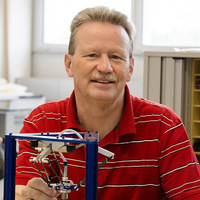
Einar Nielsen
Einar Nielsen has over 20 years’ experience in robot development. He realized sensor-guided robotic systems for industry, surgery, rehabilitation, container handling, research, haptic feedback displays or high precision and high speed robotic applications. In the more than 30 robot projects a big experience in the realization of mechanical and electrical hardware as well as in the development of robot control software has been obtained for that serve as the basis for further developments.
Einar Nielsen's research interests lie in the development and control of sensor guided robotic systems, which finds their practical used in industry, medicine, logistics or service. His main focus is on an application driven development process and philosophy, where the dynamic behavior of the robot is defined by an optimized choice of mechanical design and control strategy. The goal is to push the performance high up, while the complexity of the overall system is reduced.
Phone: +41 78 738 90 41
Address: Eisgasse 17
8004 Zurich
Switzerland
Einar Nielsen's research interests lie in the development and control of sensor guided robotic systems, which finds their practical used in industry, medicine, logistics or service. His main focus is on an application driven development process and philosophy, where the dynamic behavior of the robot is defined by an optimized choice of mechanical design and control strategy. The goal is to push the performance high up, while the complexity of the overall system is reduced.
Phone: +41 78 738 90 41
Address: Eisgasse 17
8004 Zurich
Switzerland
less
Related Authors
Marjut Arola
North Karelia University of Applied Sciences
Irma Mikkonen
Savonia University of Applied Sciences
viorica rozina chifu
Technical University of Cluj-Napoca
Wendy Moyle
Griffith University
Jari Pirhonen
Tampere University
Arshia Khan
University of Minnesota, Duluth
InterestsView All (6)







Uploads
Papers by Einar Nielsen
Within this work a detailed model of the system, including the relevant non-linearities, is derived using Matlab/Simulink. The simulation results are verified using the described hardware and the model is refined in several iterations. This allows to gain a better understanding of the existing effects and therefore to develop appropriate concepts to increase the dynamic positioning precision. Finally, the control algorithms were implemented on the servo drive as a C# real time application. Beside a conventional cascade controller structure, a so called active damping for the suppression of resonant oscillations, as well as a compensation of the gear transmission error have been implemented. By this means a maximum load position error of 150 μrad could be achieved.
Within this work a detailed model of the system, including the relevant non-linearities, is derived using Matlab/Simulink. The simulation results are verified using the described hardware and the model is refined in several iterations. This allows to gain a better understanding of the existing effects and therefore to develop appropriate concepts to increase the dynamic positioning precision. Finally, the control algorithms were implemented on the servo drive as a C# real time application. Beside a conventional cascade controller structure, a so called active damping for the suppression of resonant oscillations, as well as a compensation of the gear transmission error have been implemented. By this means a maximum load position error of 150 μrad could be achieved.